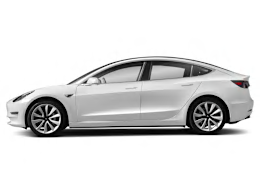Tesla's Model 3 compact sports sedan is the company's first attempt at a mass-market electric car. It is aimed at competitors like the Audi A4 and BMW 3 Series--but unlike those cars, the Tesla doesn't consume a drop of fuel.
Mid-Range 260 mile range, or Long Range 310 mile range are available. We bought a Model 3 with the Long Range battery. Our testers found the Model 3 to be fun to drive, thanks to the superb handling and immediate thrust from the electric motor. However, the Model 3's distracting controls, overly stiff ride, and uncomfortable rear seat count heavily against it.
The Model 3 is like other EVs in that it deploys its full torque instantly and rushes off from a dead stop with authority. Every prod of the accelerator pedal translates to immediate thrust in near silence.
We found that our Model 3 met the EPA rating of 310 miles per charge for the Long Range battery, and we were able to get 350 miles when the aggressive regenerative braking mode was engaged. It takes about seven hours to charge the long-range Model 3 on a 40-ampere charger or 12 hours when using a regular 240-volt charger on 32-ampere.
We were impressed by the Model 3's glued-to-the-road handling and quick, precise steering. The taut suspension keeps the Tesla from leaning when taking corners, and the car's sharp reflexes help it carve through tight turns with ease. Overall, it feels like a well-tuned sports car.
The Model 3's ride is overly stiff, like many sports cars, and it struggles to absorb bumps with any grace. Its bigger sibling, the Model S, has a far superior ride. The Model 3 also suffers from considerable wind noise at highway speeds.
From its inception, Tesla has been a company that thrives on doing things differently, and that holds true even for the Model 3's key: There isn’t one. Instead, the owner's smartphone can be used as the key. Once the Tesla app has been installed on the driver's phone (and the app is open and active), the car can sense the driver approaching, automatically unlock the doors, and allow the driver to motor away simply by putting the car in gear. Tesla also provides a credit card-like "key" card. This card allows owners who choose not to use the app to get in and drive, but it involves swiping and tapping it in two separate, specific locations to unlock and then drive the car.
Other Model 3 eccentricities seem to be there just for the sake of being different. The door handles are one example: Press on one side of the chrome lever, and then pull on the other side to open the door. It’s unnatural and awkward.
The front seats and the driving position are terrific. Visibility is expansive and clear, except in the rear, where the high package shelf hurts the driver's view to the rear. The rear seat is positioned very low to the floor, and that results in an uncomfortable seating position that completely lacks thigh support.
Suede and wood trim come with the Premium Upgrades package. That and the clean dash, large screen, and concealed air vents lend the car an avant-garde ambience.
One part of the Model 3 that stands out is the large center touch screen, which is where the driver interacts with all information and controls. The rest of the interior is almost bereft of conventional controls. We found it is highly distracting to use the screen, which, too often, forces the driver to divert their attention from the road. Users must frequently fiddle with the screen to perform common tasks and the text is small.
Autopilot, one of Tesla's signature features, is available on the Model 3. This driver-assistance system combines adaptive cruise control and autosteer. These systems allow Autopilot to vary the car's speed according to the surrounding traffic flow and can keep the car in its lane. In our tests of this system, we found that it can add convenience but could potentially lull drivers into complacency.
Tesla fans will likely love everything about the car and overlook its deficiencies. Even other buyers will revel in the car's instant power and enjoyable handling initially, but the stiff ride and unintuitive controls might wear thin over the long run.


























